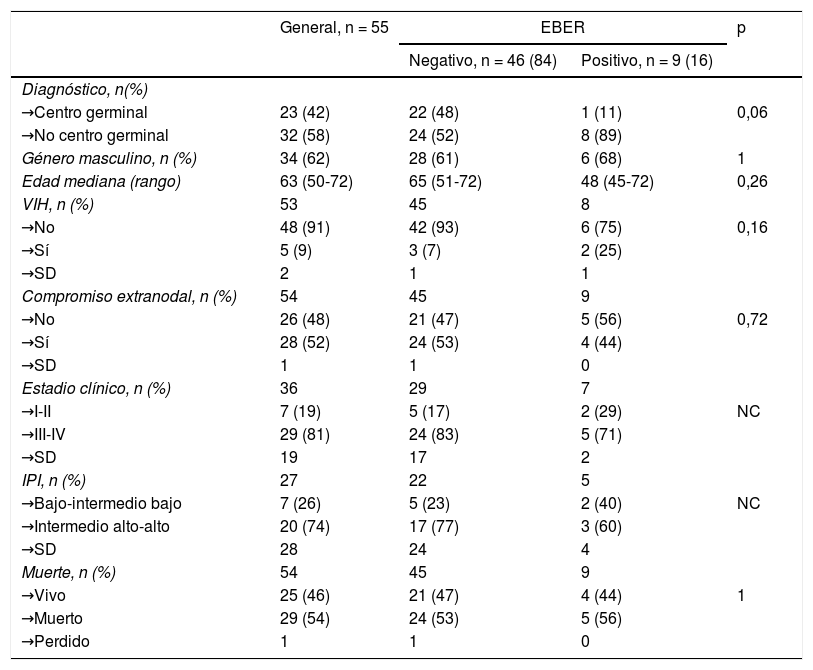El linfoma difuso de células B grandes (LDCBG) constituye el 35% de los linfomas no Hodgkin y su incidencia aumenta con la edad. El virus Epstein-Barr (VEB) está ampliamente distribuido a nivel mundial. La asociación entre el LDCBG y VEB está cerca del 10% en pacientes inmunocompetentes; este tipo de linfoma tiene alta prevalencia en países de Latinoamérica.
ObjetivoConocer la frecuencia del LDCBG asociado al VEB y describir sus características demográficas, clínicas, inmunofenotípicas y desenlace de los pacientes en un centro de alta complejidad en Cali (Colombia).
Materiales y métodosEstudio observacional descriptivo de una cohorte histórica. Se revisaron los registros clínicos y de anatomía patológica de pacientes con diagnóstico de LDCBG y se realizó la hibridación in situ para la detección del VEB (EBER). Se realizó un análisis descriptivo.
ResultadosEntre 2011 y 2017 se revisó la historia clínica de 55 pacientes con diagnóstico de LDCBG. El 16% fueron VEB positivos, los cuales fueron en su mayoría del subtipo no centro germinal (89%), con presentación nodal (56%); hubo mayor prevalencia en hombres (68%), menor edad de presentación (mediana 48 años) y muerte en el 56% de los casos.
ConclusionesLos pacientes con LDCBG y VEB positivo presentan con mayor frecuencia el subtipo no centro germinal, el cual, según nuestros hallazgos, se presenta en pacientes más jóvenes y se asocia a peor pronóstico. El EBER no es un examen que se hace de rutina, por lo cual se recomienda realizar pruebas para la detección del VEB en pacientes con diagnóstico de LDCBG.
Diffuse large B-cell lymphoma (DLBCL) accounts for 35% of non-Hodgkin lymphoma and its incidence increases with age. Epstein Barr virus (EBV) is widely spread worldwide. There is a 10% association between EBV and DLBCL in immunocompetent patients; this type of malignancy has a high prevalence in Latin American countries.
ObjectiveEstimate the percentage of association between DLBCL and EBV patients, describing demographics, clinical and immunological features, as well as phenotype and clinical outcome in a high complexity healthcare institution in Colombia.
Materials and methodsThis is an analytic observational study from an historical cohort. Clinical and pathological records were revised among DLBCL patients and subsequent in-situ hybridization was performed for EBV detection. A descriptive analysis of the data was carried out.
ResultsFrom 2011 to 2017, 55 DLBCL patients were identified. 16% were positive on ISH for EBV, most of which belonged to the non-germinal center B-cell immunophenotype (89%), with a nodal presentation (56%). DLBCL EBV positive was more prevalent among males (67%) and in younger patients (median of 48 years) where the mortality rate was 56%.
ConclusionsDLBCL patients positive for EBV are more prone to belong to the non-germinal center B-cell immunophenotype which, according to our findings, is associated with a younger age and worse prognosis. Presently, EBER in-situ hybridization is not a part of routine tests, but we recommend its inclusion in the pathology package for DLBCL patients, as it can influence clinical outcomes.
Artículo
Comprando el artículo el PDF del mismo podrá ser descargado
Precio 19,34 €
Comprar ahora













